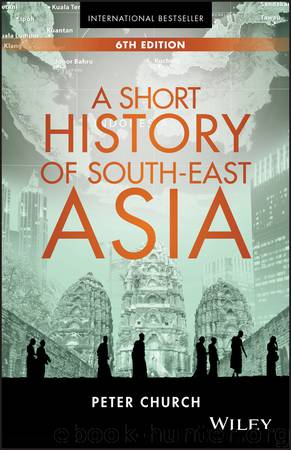A Short History of South-East Asia by Peter Church

Author:Peter Church
Language: eng
Format: epub
Published: 2017-05-01T00:00:00+00:00
7
Myanmar
Myanmar, formerly known as Burma, is a unique country in South‐East Asia. For most of the six decades since achieving independence in the aftermath of World War II, Myanmar has isolated itself from the outside world. From its prewar position as a relatively rich agricultural colony and a major exporter of rice, it has slumped to being the poorest nation in South‐East Asia. Mineral rich, in the new century it is dependent on oil imports to keep its shaky economy running. Ruled by a military regime from 1962 to 2015, for 40 years it deliberately isolated itself from the political, social, and economic forces that have swept over the rest of South‐East Asia. While in the early 1990s there were signs that economic imperatives and political pressure from both inside and outside the country were at least leading to more outward‐looking economic policies, by the first years of the new century the Asian economic crisis, continuing unresolved domestic political disputes, and international condemnation by Western governments led to a stagnant economy. And even with the first civilian government taking power early in 2016, significant political, economic, and social issues remain to be solved.
Myanmar is the most ethnically diverse state in mainland South‐East Asia. The Burmese comprise around 68 percent of the population of 54 million, but there are more than 100 ethnic groups in the country. The Burmese dominate the alluvial plains and the major towns and cities. The hills bordering neighbouring countries of India, Bangladesh, China, Laos, and Thailand are populated by ethnic minorities. These peoples have long resisted Burmese domination. The largest of the ethnic minorities are the Shans, the Karens, and the Arakanese (on the Bangladesh border). The multiethnic nature of Myanmar and the antipathy between Burmese and ethnic minorities is one important theme in Myanmar's history.
There is a strong coincidence between religious adherence and ethnic divisions. The Burmese are predominantly Buddhist, whereas the Karen and the Shan are predominantly Christian and the Arakanese are split between Buddhists and Muslims. Buddhism entered Myanmar from India from the seventh century and along with it came Hindu‐Buddhist cosmological ideas. The ethnic Burmese began their migration from southern China in the ninth century and over the succeeding thousand years steadily spread through the lowland plains of present‐day Myanmar. The Burmese embraced Buddhism. Christianity was introduced during British rule. British missionaries evangelised among the animistic hill peoples, converting the Shan, Karen, and other ethnic minorities to the Christian faith. The coincidence of ethnicity and religion has deepened the divisions between ethnic groups in Myanmar. A second major theme in Myanmar's history is a deep concern about its neighbours. The Burmese and the Thais have competed for territory, power, and wealth over hundreds of years, resorting to war where necessary and thoroughly distrusting each other in periods of peace. The Burmese have also ingrained fears of their huge northern neighbor, China (remembering the Mongol conquest at the end of the 13th century), and still‐fresh memories of the colonial period, when Indian migrants dominated the modern sector of the economy.
Download
This site does not store any files on its server. We only index and link to content provided by other sites. Please contact the content providers to delete copyright contents if any and email us, we'll remove relevant links or contents immediately.
| Africa | Americas |
| Arctic & Antarctica | Asia |
| Australia & Oceania | Europe |
| Middle East | Russia |
| United States | World |
| Ancient Civilizations | Military |
| Historical Study & Educational Resources |
The Sympathizer by Viet Thanh Nguyen(4277)
The Rape of Nanking by Iris Chang(4116)
World without end by Ken Follett(3406)
Ants Among Elephants by Sujatha Gidla(3377)
Blood and Sand by Alex Von Tunzelmann(3112)
Japanese Design by Patricia J. Graham(3087)
City of Djinns: a year in Delhi by William Dalrymple(2493)
The Queen of Nothing by Holly Black(2451)
Foreign Devils on the Silk Road: The Search for the Lost Treasures of Central Asia by Peter Hopkirk(2414)
Inglorious Empire by Shashi Tharoor(2381)
India's Ancient Past by R.S. Sharma(2378)
Tokyo by Rob Goss(2353)
In Order to Live: A North Korean Girl's Journey to Freedom by Yeonmi Park(2323)
Tokyo Geek's Guide: Manga, Anime, Gaming, Cosplay, Toys, Idols & More - The Ultimate Guide to Japan's Otaku Culture by Simone Gianni(2299)
India's biggest cover-up by Dhar Anuj(2289)
The Great Game: On Secret Service in High Asia by Peter Hopkirk(2271)
Goodbye Madame Butterfly(2184)
Batik by Rudolf Smend(2073)
Living Silence in Burma by Christina Fink(2019)
